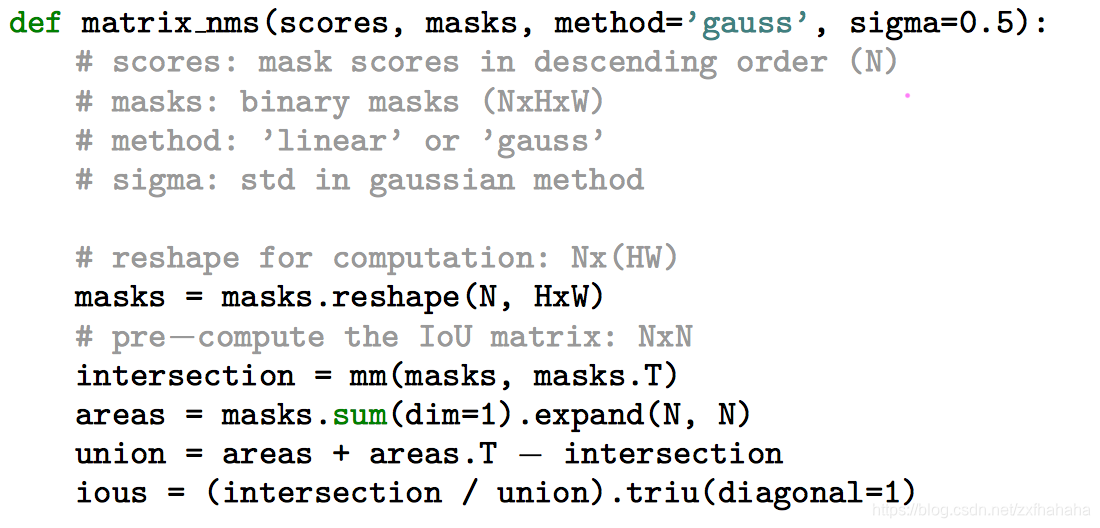NMS系列
solov2提出了Matrix NMS,这一篇就想把NMS系列总结一下。
Non-Maximum Suppression的翻译是非“极大值”抑制,而不是非“最大值”抑制。这就说明了这个算法的用处:找到局部极大值,并筛除(抑制)邻域内其余的值。
NMS
参考:https://zhuanlan.zhihu.com/p/78504109
在目标检测中,我们需要NMS从堆叠的类别一样的边框中挑出最好的那个。
主要实现的方法就是对于相同类别的,把置信度比自己低,和自己的重叠度即iou大于某一阈值的剔除(把置信度置位0)
算法流程:
- 将所有的框按类别划分,并剔除背景类,因为无需NMS。
- 对每个物体类中的边界框(B_BOX),按照分类置信度降序排列。
- 在某一类中,选择置信度最高的边界框B_BOX1,将B_BOX1从输入列表中去除,并加入输出列表。
- 逐个计算B_BOX1与其余B_BOX2的交并比IoU,若IoU(B_BOX1,B_BOX2) > 阈值TH,则在输入去除B_BOX2。
- 重复步骤3~4,直到输入列表为空,完成一个物体类的遍历。
- 重复2~5,直到所有物体类的NMS处理完成。
- 输出列表,算法结束
Soft NMS
参考:https://blog.csdn.net/app_12062011/article/details/77963494
motivation:图片上有重叠的两个类别一样的物体,用传统的nms置信度较低的那一个很可能被去除,但其实他们框的是两个不一样的物体。
解决办法:不是一遇到重叠度过高的就去除,而是将阈值降低,降低的方式有liner和高斯。
Matrix NMS
Matrix NMS是在Soft NMS的基础上改进的,因为Soft NMS整个流程是sequential即串行的,不能并行实现(implemented in parallel。
Our Matrix NMS is motivated from Soft- NMS [1].
However, such process is sequential like tradi- tional Greedy NMS and could not be implemented in parallel.
那么作者就想,怎么能实现并行呢?(soft nms求decay factor也就是每次置信度要乘的那个f(iou)是串行的)
decay factor
Matrix NMS就从另一个角度看待问题,他考虑的是一个预测出来的mask m j m_j mj 是如何被抑制的。
对于 m j m_j mj它的decay factor受两方面影响:
- 每个预测的 m i m_i mi对 m j m_j mj的penalty ( s i > s j s_i>s_j si>sj)
这个penalty通过 f ( i o u i , j ) f(iou_{i,j}) f(ioui,j)就直接可以得到 - m i m_i mi被抑制的概率
这个 m i m_i mi被抑制的概率就不容易算了,但是这个概率和IOU正相关,所以Matrix nms直接用和 m i m_i mi的iou最大(重叠度最高)的预测来近似这个概率(iou最大 那f(iou)最小,所以公式如下,反正就是找和 m i m_i mi重叠度最高的)
通过以上两点,得到 m j m_j mj的decay factor:
我自己理解:
对于 m a s k m j mask m_j maskmj,我们要通过 s j ∗ d e c a y f a c t o r s_j*decay factor sj∗decayfactor来得到新的置信度 s j s_j sj。
那soft nms是依次遍历和 m j m_j mj相同类且置信度比他高的那些 m i m_i mi,然后decay factor 就是 f ( i o u i , j ) f(iou_{i,j}) f(ioui,j)。
Matrix nms 想并行计算,想通过矩阵一次性求decay factor,他就想对 m j m_j mj置信度更新的那些 m i m_i mi,它们自己如果被抑制了,那对我的抑制作用就没了。 你人都没了,你还影响我?然后 m i m_i mi被抑制最有可能就是和他重叠度最大的那个mask干的。
f ( i o u i , j ) f(iou_{i,j}) f(ioui,j) decremented functions
和soft nms一样,有线性的和高斯的
- linear

- Gaussian

代码解读
官方代码:
solov2的/SOLO/mmdet/core/post_processing/matrix_nms.py 的matrix_nms函数
def matrix_nms(seg_masks, cate_labels, cate_scores, kernel='gaussian', sigma=2.0, sum_masks=None):
"""Matrix NMS for multi-class masks.
Args:
seg_masks (Tensor): shape (n, h, w)
cate_labels (Tensor): shape (n), mask labels in descending order
cate_scores (Tensor): shape (n), mask scores in descending order
kernel (str): 'linear' or 'gauss'
sigma (float): std in gaussian method
sum_masks (Tensor): The sum of seg_masks
Returns:
Tensor: cate_scores_update, tensors of shape (n)
"""
- 得到NxN pairwise IoU Matrix
论文中第一步是得到一个NxN的iou矩阵,也就是这N个mask 每个和其他的mask的iou
We first compute a N ×N pairwise IoU matrix for the top N predictions sorted descending by score. For binary masks, the IoU matrix could be efficiently implemented by matrix opera- tions.
伪代码:
- 首先是伪代码的第一部分:reshape for computation Nx(HW)
先按置信度选出top N个mask,文章中N选的是500。得到的seg_masks是[N,HxW],也就是每一行是一个mask的所有像素值
n_samples = len(cate_labels)#N
if n_samples == 0:
return []
if sum_masks is None:
sum_masks = seg_masks.sum((1, 2)).float()
seg_masks = seg_masks.reshape(n_samples, -1).float()#[N,HxW]
- 伪代码的第二部分:pre−compute the IoU matrix: NxN
这一部分就是计算这个iou 矩阵,iou就是要算交集和并集
对于 m i m_i mi和 m j m_j mj来说,
他们的交集就是相同位置都是1的像素点的总和
并集就是 m i m_i mi像素值的和+ m j m_j mj像素值的和-交集的值,注意代码中sum_masks_x只是把每个mask的像素值按列扩充成[N,N]了,以备后续和别人加 真正的union是union:sum_masks_x + sum_masks_x.transpose(1, 0) - inter_matrix
# inter.
inter_matrix = torch.mm(seg_masks, seg_masks.transpose(1, 0))#[N,N] torch.mm是进行矩阵相乘,对每个mask i 和 mask j 的值对应相乘加起来 作为inter_matrix[i][j]的值 即mask i和mask j相交的像素数
"""
tensor([[4081., 3931., 3918., ..., 3645., 0., 0.],
[3931., 3937., 3826., ..., 3615., 0., 0.],
[3918., 3826., 4067., ..., 3614., 0., 0.],
...,
[3645., 3615., 3614., ..., 6124., 0., 50.],
[ 0., 0., 0., ..., 0., 273., 0.],
[ 0., 0., 0., ..., 50., 0., 50.]], device='cuda:0')
"""
# union.
sum_masks_x = sum_masks.expand(n_samples, n_samples)#[N]->[N,N] 每一列的值都相同 union:sum_masks_x + sum_masks_x.transpose(1, 0) - inter_matrix
# iou.
iou_matrix = (inter_matrix / (sum_masks_x + sum_masks_x.transpose(1, 0) - inter_matrix)).triu(diagonal=1)#[N,N] triu 得到上三角矩阵 diagonal=1表示不包含对角线
"""
tensor([[0.0000, 0.9618, 0.9262, ..., 0.5556, 0.0000, 0.0000],
[0.0000, 0.0000, 0.9157, ..., 0.5608, 0.0000, 0.0000],
[0.0000, 0.0000, 0.0000, ..., 0.5495, 0.0000, 0.0000],
...,
[0.0000, 0.0000, 0.0000, ..., 0.0000, 0.0000, 0.0082],
[0.0000, 0.0000, 0.0000, ..., 0.0000, 0.0000, 0.0000],
[0.0000, 0.0000, 0.0000, ..., 0.0000, 0.0000, 0.0000]],
device='cuda:0')
"""
- 得到类别相同 label_specific matrix
这一部分伪代码没有体现,但上一部我们得到的iou_matrix是和其它所有mask的交集,但我们知道nms其实就是筛掉和自己类别相同的
# label_specific matrix.
cate_labels_x = cate_labels.expand(n_samples, n_samples)
label_matrix = (cate_labels_x == cate_labels_x.transpose(1, 0)).float().triu(diagonal=1)#[N,N] 把mask i 和maski 的label一样的值为1
"""
tensor([[0., 1., 1., ..., 0., 0., 0.],
[0., 0., 1., ..., 0., 0., 0.],
[0., 0., 0., ..., 0., 0., 0.],
...,
[0., 0., 0., ..., 0., 0., 0.],
[0., 0., 0., ..., 0., 0., 0.],
[0., 0., 0., ..., 0., 0., 0.]], device='cuda:0')
"""
- max IoU for each: NxN 计算decay factor的分母
Then we get the most overlapping IoUs by column-wise max on the IoU matrix.
这一部分我们求的是mi被抑制的概率,还记得论文是怎么表示这一部分的吗,就是用和他重叠度最高的那个iou来表示
# IoU compensation
compensate_iou, _ = (iou_matrix * label_matrix).max(0)#[N] 对每个mask i 找到和他相同类别的 最大iou 即论文伪代码的ious_cmax max(0)是找到每一列的最大值
compensate_iou = compensate_iou.expand(n_samples, n_samples).transpose(1, 0)#[N,N] 每一列的值一样
- 计算decay factor
Next, the decay factors of all higher scoring predictions are computed, and the decay fac- tor for each prediction is selected as the most effect one by column-wise min (Eqn. (4)).

上面已经得到了分子要的decay_iou:和自己类别相同且置信度比自己高的iou的值
分母要的compensate_iou: 重叠度最高的最大iou
那算decay factor就是看用高斯还是线性的,套公式即可
# IoU decay
decay_iou = iou_matrix * label_matrix #[N,N] decay_iou[i][j] mask i 和maskj 的iou,且类别相同
# matrix nms
if kernel == 'gaussian':
decay_matrix = torch.exp(-1 * sigma * (decay_iou ** 2))
compensate_matrix = torch.exp(-1 * sigma * (compensate_iou ** 2))
decay_coefficient, _ = (decay_matrix / compensate_matrix).min(0)
elif kernel == 'linear':
decay_matrix = (1-decay_iou)/(1-compensate_iou)
decay_coefficient, _ = decay_matrix.min(0)#[N] decay_coefficient 对应的就是这N个mask被抑制的概率 就是论文的decay factor
else:
raise NotImplementedError
- 得到新的置信度
Finally, the scores are updated by the decay factor. For usage, we just need threshing and selecting top-k scoring masks as the final predictions.

# update the score.
cate_scores_update = cate_scores * decay_coefficient
return cate_scores_update
来源:oschina
链接:https://my.oschina.net/u/4382386/blog/4406293



